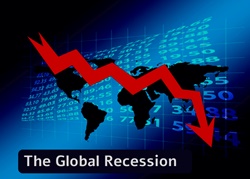Recession
What is a Recession?
A recession is defined as two consecutive quarters of negative Gross Domestic Product (GDP) growth. In simple terms, it means that that GDP declines for two three-month periods in a row, or that the output of the Economy shrinks. But, the National Bureau of Economic Research, which decides the official timing of expansions and recessions, defines recession as "a recurring period of decline in total output, Income, employment, and trade, usually lasting from six months to a year, and marked by widespread contractions in many sectors of the economy." Thus, along with the length of the decline, its breadth and depth are also considerations in determining an official recession.

Recession is when the Gross Domestic Product (GDP) is negative for more than two consecutive quarters. However, this is not the only indicator of a recession. It could begin even before the quarterly GDP reports are out. When a recession occurs, there are five economic indicators to note i.e. real gross domestic product, Manufacturing, retail sales, income and employment. When there is a decline in these five indicators, it will automatically translate into the national GDP.
Julius Shiskin, Commissioner of the Bureau of Labour Statistics, 1974 defined recession with a few indicators to help people understand whether a country is experiencing a recession. In 1974, people were not really sure how to understand whether the country was suffering from it in the U.S. This was because the economy in the U.S. was undergoing stagflation caused by President Richard Nixon’s economic policies. Along with this, the wage and price controls had created Inflation.
The indicators are mentioned below:
- Decline in the real GDP for two consecutive years
- A 1.5% fall in the real gross national product
- Fall in manufacturing over a 6-month time period
- A 1.5% fall in non-farm payroll employment
- Fall in employment in more than 75% of industries for more than a period of 6 months
- Increase in unemployment to a level of at least 6%
Macroeconomic Components of Recessions
The standard macroeconomic definition of a recession is two consecutive quarters of negative GDP growth. Private business, which had been in expansion prior to the recession, scales back production and tries to limit exposure to systematic risk. Measurable levels of spending and investment are likely to drop and a natural downward pressure on prices may occur as aggregate demand slumps.
Microeconomic Components of Recessions
At the microeconomic level, firms experience declining margins during a recession. When revenue, whether from sales or investment, declines, firms look to cut their least-efficient activities. A firm might stop producing low-margin products or reduce employee compensation. It might also renegotiate with creditors to obtain temporary interest relief. Unfortunately, declining margins often force businesses to fire less productive employees.
Talk to our investment specialist
How does Recession Affect Individuals?
When a recession occurs, unemployment becomes the trend in the nation. The rise of the unemployment rate causes purchases to fall drastically. Businesses are affected as well in the process. Individuals become bankrupt, lose their housing properties just because they can’t afford to pay the rent anymore. Unemployment is negative for young people’s education and career choices.
You can understand or at least take notice that a recession is on its way when you notice a change in the manufacturing Industry. Manufacturers may get large orders in advance. When the orders decline over time, the manufacturers will stop hiring people. The decline in consumer demand causes a fall in sales which is usually why recession can be noticed early.
Recession Incidence
A good example is the Great Recession. There were four consecutive quarters of negative GDP growth in the last two quarters of 2008 and the first two quarters of 2009.
The recession quietly started in the first quarter of 2008. The economy contracted slightly, only 0.7 percent, rebounding in the second quarter to 0.5 percent. The economy lost 16,000 jobs in January 2008, the first major job loss since 2003. That's another sign the recession was already underway.
Recession Vs Depression
There are key elements that are the main points of difference between both.
They are mentioned below:
| Recession | Depression |
|---|---|
| The GDP contracts for two consecutive years or more in recession. The GDP growth will slow down for a number of quarters before finally becoming negative | The Economy contracts for a number of years in depression |
| Income, employment, retail sales and manufacturing all take a hit. Monthly reports can indicate the same | Depression is there for a long period of time and income, manufacturing, retail sales are all affected for years. The Great Depression 1929 caused the GDP to be negative for 6 years out of 10 |
All efforts have been made to ensure the information provided here is accurate. However, no guarantees are made regarding correctness of data. Please verify with scheme information document before making any investment.






